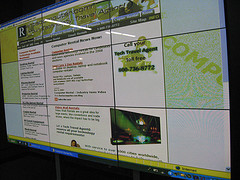What is a Video wall and what are its components?
This article provides an insight to Video walls – What are video walls, the technology used in a video wall, what are video wall controllers, video wall management software and rear projection display cubes and how all of them combine to give a big display.

Picture Courtesy: http://www.flickr.com/people/johnbeagle/
Have you ever looked at huge display systems – like the ones available in the control rooms, Stock exchanges etc. and wondered what could be the technology behind them? There is a good chance that you might have looked at a video wall.
A video wall is formed by grouping multiple “rear-projection display cubes” and arranging them next to one another (or forming a 2×2 or 3×3 shape) and making all these individual cubes to display a single image (like what is shown in the picture above) so that the image looks very big and appears to come from a single display source. Video walls were required because there is no single huge display source which can provide high resolution, high contrast and uniform brightness. A video wall is formed by the combination of the following three technologies.
Rear-Projection Display Cubes:
The basic display element of a video wall (which can also operate individually) is a display cube. The display cube is built with a rear projection DLP projector (normally) and a screen to show the output. The display cube may be supported by adjustable stands and can be arranged next to each other or over one another without the viewer knowing that there is a boundary between any two of them.
These DLP projectors normally have a very high contrast ratios (In the range of ANSI 650:1) which helps in the projection of minute objects accurately. They also control the brightness uniformly across the screen for good viewing experience. They typically use mercury vapour UHP type lamp which may have a maximum life of 4000 hours and in the brightness range of 2500 Lumens. They generally support multiple resolutions from XGA to SXGA+.
Typical display cube sizes range from 50″ to 100″ diagonal. Some of them offer 4:3 aspect and some of them offer 16:9 aspect. They are also available in curved versions and movable types.
There are generally two lamps which might operate simultaneously and they provide redundancy too. The lamp is a consumable and ought to be replaced.
Video wall Controller:
The video wall controller is basically a hardware computer server running a network operating system like Windows 2003 Server edition etc. They are designed for 24 x 7 operation and accept inputs from various sources like Cameras, satellite imagery, video recorders, DVD/VCR players, computers etc. and support a wide range of input formats like multiple RGB input, video, BNC connectors, HD, DVI etc. They run specialized dual core or quad core processors with RAM capacity upto 4 GB (Generally). They also support expansion for additional input like HD-SDI and PCI-x based expansion.
Video wall management software:
Well, since there are multiple inputs coming into the video wall(s) and all these need el simultaneously displayed, there ought to be a management software which displays which source is displayed in which cube(s) and how long. The tiled video wall actually forms a single desktop display. Within that desktop display, software applications, external videos, external computer outputs, client monitors etc. can be displayed anywhere, any size. This can be controlled by the wall (through a remote control) or via a networked remote client.
They can show up to sixteen real time videos per display (generally). They support text overlays, flexible scheduling (when to display what) and also API’s which developers can used to extend the functionality or program additional features. The whole image can be viewed live over remote monitors over IP for customization. They support web-based remote management and PIP – Picture in Picture.
So, you can have all the display cubes display a single display or have individual or combination of cubes display separate displays. And you can control where to display what and when.
excITingIP.com
In case you have any specific questions, you could get in touch with us using the contact form or leave a comment below. You could also participate in the discussions in the Forum.
Related Reading: Advantages of LED Illumination for rear projection control room video walls.
i would like to know more about this video wall and how it works..please do get in touch via ma cell phone because my church would be needing one for its activities..